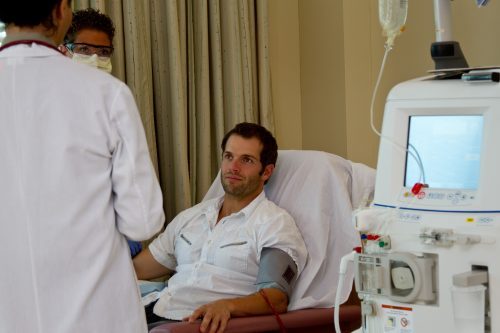
In patients with kidney failure, improved health-related quality of life (HRQoL) is seen as a touchstone of quality of care. Yet, according to Adrian R. Levy, PhD, and colleagues, the many aspects of care in that patient population are largely based on biomarkers. The initiation and treatment of kidney replacement therapy among patients with chronic kidney disease is guided by estimated glomerular filtration rate and other biochemical values.
Biochemical markers are inadequate proxies for direct measures of HRQoL. The Centers for Medicare & Medicaid Services require routine assessment of HRQoL with the completion of the Kidney Disease Quality of Life 36 (KDQOL-36) each year. The KDQOL-36 is designed to quantify the overall burden of disease; more than 50% of patients on maintenance dialysis report fatigue, pain, cramps, pruritis, sleep disorders, or sexual dysfunction.
Treatment for metabolic complications of kidney failure is common and well understood; however, less is known about the effect of metabolic complications on symptoms such as secondary hyperparathyroidism. More than half of patients with kidney failure receiving kidney replacement therapy experience hyperparathyroidism, characterized by elevated parathyroid hormone (PTH) level and associated with dysregulation of calcium and phosphorus metabolism.
It is unclear whether patients can detect symptoms associated with hyperparathyroidism. Dr. Levy et al. conducted a prospective cohort study designed to examine whether changes in PTH levels are associated with changes in symptoms in patients with kidney failure receiving hemodialysis. Results of the study were reported in the American Journal of Kidney Diseases [2020;73(3):373-383].
The outcomes of interest were changes in 19 symptoms measured up to four times using a self-administered questionnaire that assessed severity on a five-level scale. The 19 symptoms of interest were: tiredness, overall weakness, shortness of breath, diarrhea, vomiting, nausea, loss of appetite, joint aches, joint stiffness, bone aches, bone stiffness, muscle soreness, muscle pain, headaches, back pain, overall pain, itchy skin, skin problems, and difficulty sleeping.
Eligible patients were ≥18 years of age, had been receiving maintenance hemodialysis three times a week for at least four months, had been diagnosed with or treated for secondary hyperparathyroidism for at least 4 months, and were able to complete the English informed consent form and the symptom assessment questionnaire. Exclusion criteria were participation in another study involving an investigational device or drug within 4 months of screening, pregnancy or lactation, inability to sign the informed consent form, or unlikely to be able to complete the symptom assessment questionnaire.
A total of 204 patients were enrolled in the study; of those, 165 (80.8%) had complete data at baseline and at least one follow-up visit. Of the 165 in the final cohort, mean age was 56.0 years and 54.5% were women. A total of 80 participants (89%) had PTH level <600 pg/mL and 40 (24.2%) had PTH level >1000 pg/mL. Nearly all (92.7%) were being treated with vitamin D and phosphate-binder therapy (92.1%); 49.1% of participants were using cinacalcet. The proportions of patients on those therapies remained largely stable over time during follow-up visits at week 4, 12, and 24.
There were 646 PTH measurements gathered for the 165 participants followed up over four visits: 14 participants were missing laboratory values over a total of 660 possible measurements; 151 participants had all four measurements, 11 had three, and three had two. For all measurements, the mean number of days between measurement of PTH and symptoms was 24.0.
In analyses of the pattern between change in PTH levels and the probability of at least one increase in symptom severity (none to mild, mild to moderate, moderate to severe, or severe to very severe), there was a monotonically increasing curve, indicating a trend for worsening of symptoms with increased in PTH levels from 0 to 2000 pg/mL between visits for bone aches, joint aches, and overall pain. A U-shaped curve for bone stiffness and nausea indicated symptom worsening with greater values of absolute difference in PTH levels.
Increases in PTH levels over time were associated with worsening of bone aches and stiffness, joint aches, muscle soreness, overall pain, itchy skin, and tiredness (P<.01). Larger changes in PTH levels were associated with more pronounced effects.
The researchers cited some limitations to the study findings, including possible confounding due to unmeasured comorbid conditions, concomitant medications, and multiple testing coupled with a P value threshold of 0.10.
In summary, the researchers said, “The findings reported here suggest that worsening of secondary hyperparathyroidism may be associated with one or more clusters of symptoms, including aches/soreness/pain, itchy skin, and tiredness. Given that this study aimed to generate hypotheses, not test them, any meaningful relationships observed in this study require further confirmation before they can be used by patients and clinicians to determine treatment approaches. If validated, these findings may be useful for the development of a disease-specific patient-reported outcome measure that enables patients and clinicians to determine a treatment approach based on symptom reduction and PTH biomarkers.”
Takeaway Points
- Researchers conducted a prospective cohort study to determine whether changes in parathyroid hormone (PTH) are associated with changes in symptoms in patients with kidney failure on hemodialysis.
- Generalized additive models were used to assess longitudinal associations between changes in PTH levels and symptom severity.
- There was an association between increases in PTH level over time and worsening of bone aches and stiffness, joint aches, muscle soreness, overall pain, itchy skin, and tiredness.







 © 2025 Mashup Media, LLC, a Formedics Property. All Rights Reserved.
© 2025 Mashup Media, LLC, a Formedics Property. All Rights Reserved.